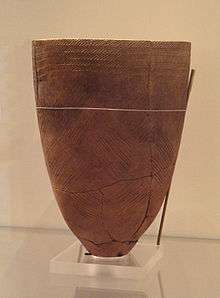Comb Ceramic

Comb Ceramic or Pit-Comb Ware (in Europe), Jeulmun pottery or Jeulmun vessel (in Korea) is a type of pottery subjected to geometric patterns from the comb-like tool. This type of pottery was widely distributed in the Baltic, Finland, the Volga upstream flow, south Siberia, Lake Baikal, Mongolian Plateau, Liaodong Peninsula and the Korean Peninsula[1]. The oldest ones have been discovered from the remains of Liao civilization - xinglongwa culture (BC 6200 - 5400 BC) -.[2] It appears in 4200 BC in Finland and 4000 BC in the Korean Peninsula, so the Urheimat is assumed to be Liao region and spread afterward to North Europe through Siberia and to Korean peniusla.
This is possibly related to Uralic migration and spread of haplogroup N (Y-DNA). In recent genetic analysis of ancient human bones excavated from the remains of Liao civilization (Hongshan culture etc.), haplogroup N1 (Y-DNA) was found with high frequency of 60-100%.[3] So, a new possibility arose that the Urheimat of both Uralic peoples and Comb Ceramic is the Liao river region.
Cultures
- Pit–Comb Ware culture - in Finland, Baltic and Russia
- Jeulmun pottery period - in Korean peninsula
See also
References
- ↑
- ↑ 中国北方新石器文化研究の新展開【詳細報告】「東北アジアにおける先史文化の交流」 王 巍(中国社会科学院考古研究所・副所長)(in Japanese)
- ↑ Yinqiu Cui, Hongjie Li, Chao Ning, Ye Zhang, Lu Chen, Xin Zhao, Erika Hagelberg and Hui Zhou (2013)"Y Chromosome analysis of prehistoric human populations in the West Liao River Valley, Northeast China. " BMC 13:216